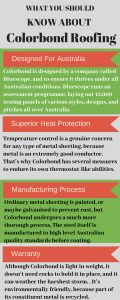In many parts of the third world, corrugated metal is a popular choice for roofs, shacks, construction fences, and water tanks. However, thus is mostly low-grade metal sheeting that has to be weighed down with heavy stones to keep it from being blown off by the wind.
These roofs sometimes collapse in heavy rain and are extremely susceptible to fire, because they are held up with wooden poles and frames. Plus, they make the house unbearably hot during the day and cause teeth-rattling chills at night.
Fortunately, Colorbond roofing is nothing like that. This superior form of metal sheeting is good enough for iconic buildings like Margaret Court Arena and the Adelaide Velodrome. Apart from roofs, fences, and tanks, Colorbond can be used for garage doors, walls, sheds, patios, and pergolas. It’s been manufactured, designed, and tested locally since 1966.
Designed For Australia
Colorbond is designed by a company called Bluescope, and to ensure it thrives under all Australian conditions, Bluescope runs an assessment programme, laying out 12,000 testing panels of various styles, designs, and pitches all over Australia. The panels mimic typical weather conditions as well as exposure. Testing covers marine and industrial areas too.
Australia has a bushfire problem, but your Colorbond roof, walls, and water tank will be safe, both from the flames themselves and floating embers. It’s tested and proven with a rating of Bushfire Attack Level – Flame Zone (BAL-FZ) and undergoes fire testing by being immersed in flames for 30 minutes. This test ensures your house is still safe if neighbouring areas are burning down. Furthermore, Colorbond is tested for durability, corrosion, and application.
Superior Heat Protection
Temperature control is a genuine concern for any type of metal sheeting, because metal is an extremely good conductor. That’s why Colorbond has several measures to endure its own thermostat-like abilities. It utilises Bluescope’s patented Thermatech technology to reflect the sun’s rays, meaning less heat gets into the home. This lowers your air conditioning bill.
Colorbond comes in 22 colours, and within that range, 5 of them have been specifically designed to be lighter, solar reflective shades for hotter regions. That said, 21 colours (including the five lighter shades and excluding Night Sky) are infused with Thermatech.
Colorbond roofs don’t need to be washed, though you can hose the flashings and soffits every six months or so, since they’re not exposed to rain. If you live in a beach town, near a salt water lake, or in an industrial region, hose the ‘dry’ areas of the roof a bit more frequently to get rid of sand, salt, and fallout. Walls and fences should be regularly hosed with fresh water.

COLORBOND ROOFING
Manufacturing Process
Ordinary metal sheeting is painted, or maybe galvanised to prevent rust, but Colorbond undergoes a much more thorough process. The steel itself is manufactured to high level Australian quality standards before coating. The base coat depends on the type of panel. If it’s stainless steel, it isn’t coated, and if it’s Permagard or Zincalume, it’s galvanised.
Other types of Colorbond are coated with Activate technology to make it resistant to corrosion, followed by a thin layer of pre-treatment. This helps additional layers fuse to the metal more efficiently. The next coat to be baked onto the steel sheet is a primer, followed by a top coat of coloured paint. This paint is specially designed for outdoor use and is baked into place. It offers UV protection, and can resist flaking, chipping, and blistering. The colours are categorised into classic, matte, ultra, and contemporary shades.
Warranty
Although Colorbond is light in weight, it doesn’t need rocks to hold it in place, and it can weather the harshest storm. It’s environmentally friendly, because part of its constituent metal is recycled, and the product itself can be recycled once you’re done with it. It doesn’t even need further processing – it can be repurposed just as it is.
Still, it comes with a 20 year warranty, so it’ll be a while before it’s ready for the trash pile, recycled or otherwise. To ensure your Colorbond is genuine, check for the branding in ink or laser. It’s usually on the reverse side of your panels and doors, or on the inside of gutters. Fencing is laser branded on either side. The branding appears three times per 2.4m stretch.